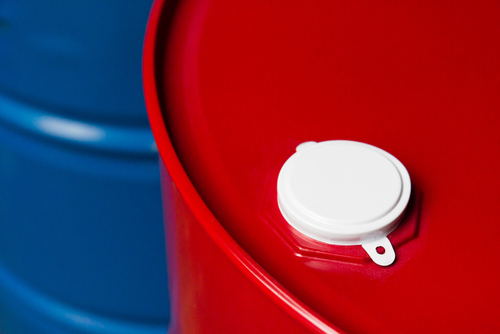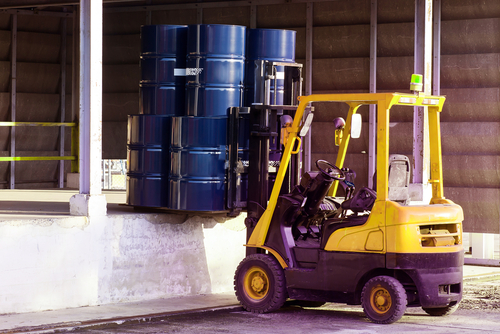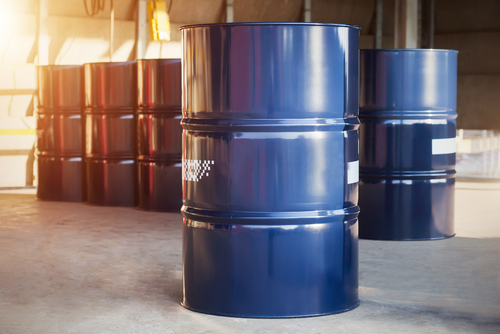
Barrels allow you to store substantial amounts of bulk foods, such as grains, in an airtight and insect-proof container. But not all plastic barrels are safe for food use.
If you are planning to ship or store food, consider purchasing food grade plastic barrels. They have been approved by the Food and Drug Administration (FDA) for use in food packaging.
RIC Code
The RIC, or Resin Identification Code, is an important marking found at the bottom of a food grade plastic barrel inside a small triangle. This number identifies the type of resin used in the manufacture of the plastic.
Foodstuffs are shipped most often in barrels with RIC codes of #2, #4 and #5.
A #2 code indicates the plastic is made of high-density polyethylene, #4 equates to low-density polyethylene, and #5 means the barrel consists of polypropylene.
High-density polyethylene (HDPE), in addition to use in food grade barrels, is the standard packaging material for freezer bags, grocery bags, and milk containers. RIC code #2 plastics do not contain bisphenol A, or phthalates, which could potentially become a food contaminate.
Type 4 or #4 RIC code materials for condiment squeeze bottles. This type of plastic is rigid yet flexible, making it ideal for uses of this type.
Manufacturers use the Type 5 or polypropylene plastic for yogurt containers, drinks, and medicines. Polypropylene is flexible like Type 4, semi-transparent and has a high resistance to solvents. You may see a Type 5 container stamped “PP.”
High-Density Polyethylene (HDPE)
This type of plastic is the most popular type used for food and beverage shipments. Stable and inert, this material is unlikely to release any potentially harmful chemicals that could contaminate the foodstuffs.
The FDA rates HDPE as “food grade.”
Food Grade Versus Food Safe
The FDA uses two designations for materials acceptable for storing foodstuffs and beverages: Food grade and food safe.
Food Grade
The designation of Food Grade on a drum means the packaging has been determined as safe for long-term storage of foodstuffs. The plastic has been tested and determined to have no harmful dyes, no recycled plastic containing leachable chemicals or any of substances that could be harmful to humans. There are other materials used for food grade drums also, such as steel.
In addition to the RIC code, containers meeting the FDA criteria will be stamped “food grade.”
Food Safe
Food safe has a similar meaning, but ‘food safe’ does not mean the FDA has approved the container for long-term storage. High-density polyethylene that is food safe can be used for things like food preparation equipment, rain barrels, and cutting boards. Any food items that come in contact with food safe materials remain safe to ingest.
Barrel Color
Food grade barrels and buckets usually come in white. This is because the white dye used to color the barrels, Titanium Dioxide, has been thoroughly tested and deemed lacking any harmful ingredients. Sunscreen, for example, uses Titanium Dioxide, and many foodstuffs also contain the compound.
Additional Symbols Found on Food Grade Barrels
Containers for food stores often have other symbols in addition to the RIC codes. A cup and fork indicate you can store food in it.
Smaller, microwave-safe containers have radiating waves stamped on the plastic. Other symbols used include things like a snowflake for freezer safe and dishes in water indicating it is dishwasher safe.
Process Indicator Codes
The process indicator code (PIC) is usually found on the food packages inside the food grade barrels, but could also be indicated on the barrel.
This code describes the process used to prepare the food product inside. There are 14 possible codes. If the food has not been processed, you will see a B, C, or D on the package.
UN Barrel Ratings
The United Nations has yet another barrel code requirement for shipping containers. A food barrel will always start the string of UN code letters and numbers with a “1.” This means it is a barrel.
The next letters and numbers refer to the material used in the drum construction, whether it is an open- or closed-headed drum, and the types of packaging you can include inside.
Bio-Plastics
A bio-plastic substance means the plastic material is either completely or partially made from organic material, rather than petroleum-based substances only. Most often, this means the manufacturers use starch and cellulose to create the plastic.
You can store food in bio-plastic containers. Generally, bio-plastics are marked with a RIC #7. However, this code applies to other materials in addition to bio-plastics, so do not rely solely on the RIC code to determine the make of the material.

